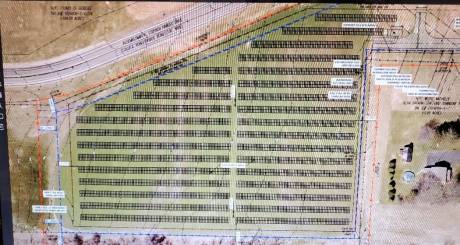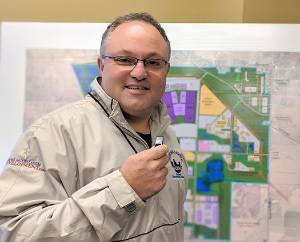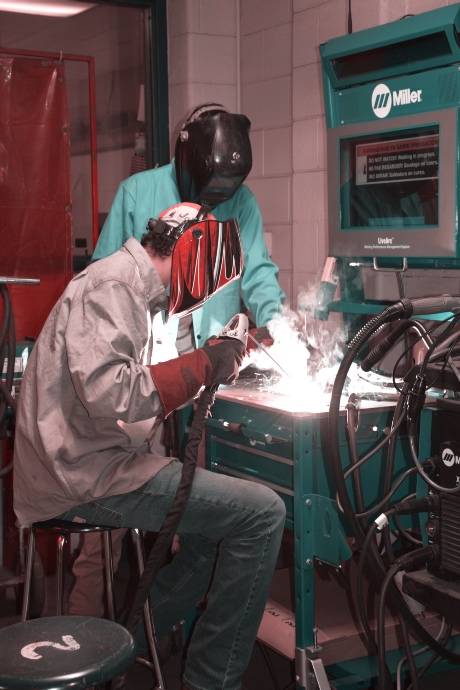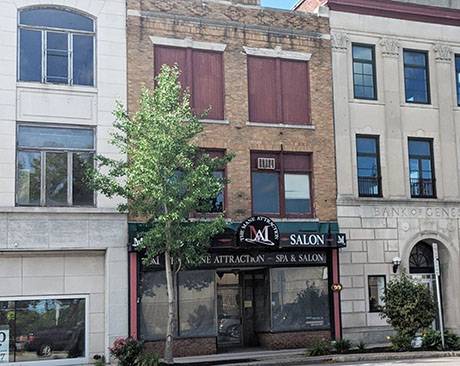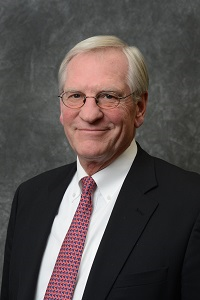The Batavia Town Planning Board was introduced to another community solar project on Tuesday night – a plan to install a 1.65-megawatt system on vacant land owned by the Genesee Gateway Local Development Corp. on R. Stephen Hawley Drive (College Road) – and, right away, was peppered with comments about the need to shield the array from a nearby home.
Planners held a public hearing in connection with a special use permit request by Batavia Solar LLC to put the ground-mounted solar farm at 99 Med Tech Drive, near the Genesee County Economic Development Center office.
James Taravella, senior civil engineer with LaBella Associates, Orchard Park, told the board that 5.63 acres of the 7.95-acre parcel, located in a Planned Unit Development district, will be fenced in for this solar array. He said the project calls for the installation of approximately 4,500 modules using a fixed access racking system.
Other features of the project include an access road with a 13- by 20-foot equipment pad and a 6 foot high chain-link fence around the entire layout. Taravella said all setbacks are in line with requirements of the PUD District – 50-foot front setback, 30-foot side setback and 40-foot rear setback.
As soon as he finished, Tim Morrow, a resident of Ellicott Street Road, asked if the owners of a home near the proposed solar array have been contacted about the project, stating that he is “looking out for the town and the community because I have the situation out by my house.”
Morrow has spoken out at previous public hearings and meetings against the Trousdale Solar I and Trousdale Solar II projects proposed for land owned by Donald Partridge at 5117 Ellicott Street Road.
Taravella: 'We're Communicating with the Neighbors'
Taravella said that representatives of Batavia Solar LLC are communicating with Robert and Michelle Wood of 8244 Batavia-Stafford Townline Road, whose home is in close proximity to the proposed solar array.
Morrow then asked if the developers planned to shield the solar farm with a berm or trees.
“At this early stage we have not put any screening but it is typical for a screening plan to be implemented as the project progresses,” Taravella said, adding that he plans to work with the Woods to “develop something that they will be happy with.”
Town Building Inspector Dan Lang informed those on the Zoom call that the Town of Batavia has specifications for its solar projects, including a decommissioning bond and a call for trees, berms and surface vegetation to ensure a view “that is as natural as possible in accordance with our code.”
At that point, Michelle Wood spoke up, acknowledging that she and her husband are the landowners.
“We really would like a berm put along the back of it – it protects us and our house,” she said. “We’re OK and in favor of a solar farm there. We would prefer a solar farm versus a cement industrial building there, so we don’t have a real problem with it. We would just like for them to come to us with what their ideas are and what they’re planning to do.”
Planners Want Extensive Screening
Later on, during the regular meeting, planners asked Taravella to develop a screening plan that shields the Wood house “not only from looking out their back window but also from their side window, over to the driveway” and asked him to create visual simulations showing as such.
Furthermore, board members requested screening around the entire project, including the view from College Road. Taravella said that is an early consideration as developers have to make sure that some of the fixed-angle panels are not shaded by trees or berms.
Going forward, Town Engineer Steve Mountain advised that developers should submit a long-form State Environmental Quality Review to provide as much information to the planning board, which then voted in favor of seeking lead agency status for the project.
Planning Board Chair Kathy Jasinski said the board will invite Taravella back after getting the SEQR form, which takes about 30 days, and talk about the special use permit.
In other action, the planning board:
- Following a public hearing, approved a special use permit for Janice Smith, 9149 Creek Road in the Town of Batavia, to convert an existing barn in an agricultural-residential district as a venue for weddings and other events.
“I have a large barn; I have property,” Smith said. “We went through this last year with my son where he got married, and he didn’t have a place to have it, so I would like to offer that (option) to other people. We don’t really have anything like that around here so …”
Discussion centered around the number of parking spots available on the property and whether the surface would be paved or left as grass.
Smith said there would be 157 parking spots on a grass surface, adding that the ground was “completely flat” and that she didn’t anticipate any problems being that the barn would be used during the warm weather months.
Town Building Inspector Dan Lang said that he has made several visits to the site and found “no difficulties” as the ground was solid, and there also were areas of stone and gravel.
Smith also responded to a question about possible noise issues related to music being played at the venue but said there are no neighbors for miles to the east or west and the closest neighbor otherwise were her parents.
Previously, the referral was recommended for approval by the Genesee County Planning Board with modifications that the applicant provide a revised site plan with the location and number of parking spots serving the party venue; and applies for 9-1-1 Address Verification to the Genesee County Sheriff's Office to ensure that the address of the proposed event venue meets Enhanced 9-1-1 standards*.
*Enhanced 911, E-911 or E911 is a system used in North America to automatically provide the caller's location to 9-1-1 dispatchers. 911 is the universal emergency telephone number in the region.
- Approved a site plan and SEQR and declared itself as lead agency for the construction of a LandPro (John Deere sales and service company) sales, storage and maintenance facility at 4554 W. Saile Drive, near the Volvo Rents equipment building.
The venture initially came before the board in December and was also reviewed by county planners.
“I think you might be pretty familiar with the project by now. Obviously, we’re looking to go ahead and build on approximately 14 and a half acres on West Saile Drive,” said Project Designer Andrew Schmieder.
Schmieder said the project consists of a 28,000-square-foot maintenance building with about 15 bays for work on agricultural equipment and another five or six bays for work on turf equipment. He said that the main sales and parts storage facility is around 22,000 square feet and it will include office space to accommodate the transfer of administrative employees to the site.
Additionally, there will be about 7,000 square feet allocated to parts storage and LandPro officials are proposing to erect a 200- by 75-foot pole barn for cold storage, Schmieder said.
“This site lends itself very well to what’s being proposed – we’ve got a lot of room out there,” he said. “There’s an area out front to display some of their turf and ag equipment.”
Responding to concerns over increased traffic, Schmieder said he didn’t expect a significant change. He said during peak hours, they expect 10 to 15 vehicle customers per hour, and three to four cargo deliveries per day to the facility that will house about 65 employees.
Schmieder reported that there will be a minimum of 70 parking spots for employees and another 40 for retail customers, including six handicapped parking spaces.
Final approval is contingent upon final town engineering review and approval. Work is anticipated to be completed in the spring or summer of 2022.
Rendering at top (taken from Zoom meeting) shows the proposed solar project on Med Tech Drive off R. Stephen Hawley Drive (College Road), The Wood residence is at the right.

